
Ipomopsis aggregata is a species of biennial flowering plant in the phlox family (Polemoniaceae), commonly known as scarlet trumpet, scarlet gilia, or skyrocket because of its scarlet red flowers with lobes curving back as if blown back by rocketing through the air.
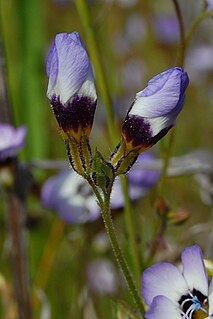
Gilia tricolor is an annual flowering plant in the phlox family (Polemoniaceae).
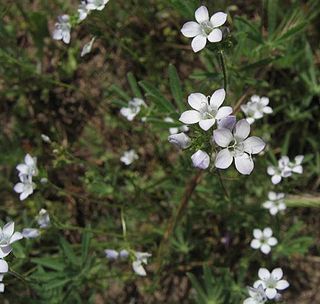
Gilia angelensis is a species of flowering plant in the phlox family known by the common name chaparral gilia. It is native to the coastal hills and mountains of California and Baja California, where it is a member of the chaparral ecosystem., especially in the Transverse Ranges.

Gilia brecciarum is an annual flowering plant in the phlox family (Polemoniaceae), known by the common name Nevada gilia or break gilia.

Gilia cana is a species of flowering plant in the phlox family known by the common name showy gilia. It is native to California and Nevada where it grows in open areas with gravelly and sandy soils, such as desert and rocky slopes. The Mojave Desert range of some subspecies may extend into Arizona.

Gilia capitata is a species of flowering plant in the phlox family known by the common names blue-thimble-flower, bluehead gilia, blue field gilia, and globe gilia.

Gilia clivorum is a species of flowering plant in the phlox family known by the common names purplespot gilia and many-stemmed gilia. It is native to California and Arizona.

Gilia latiflora is a species of flowering plant in the phlox family known by the common names hollyleaf gilia and broad-flowered gilia. It is endemic to deserts and mountains of southern California and the adjacent margin of Nevada.
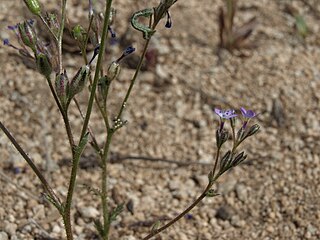
Gilia malior is a species of flowering plant in the phlox family known by the common name scrub gilia. It is native to California and Nevada, where it grows in sandy and rocky soils in the lower and mountain habitats in the Mojave Desert.
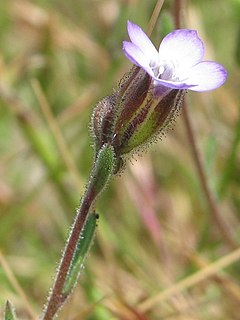
Gilia millefoliata is a species of flowering plant in the phlox family known by the common name manyleaf gilia. It is native to the coastline of Oregon and northern California, where it grows in sand dune habitat.
Gilia ophthalmoides is a species of flowering plant in the phlox family known by the common name eyed gilia. It is native to the Southwestern United States where it can be found in woodlands and high desert plateau.

Gilia scopulorum is a species of flowering plant in the phlox family known by the common names rock gilia and Rocky Mountain gilia. It is native to the Mojave and Sonoran Deserts.

Gilia sinuata is a species of flowering plant in the phlox family known by the common names rosy gilia and rosy phlox. It is native to western North America from British Columbia to New Mexico, where it can be found in a number of open habitats, generally in sandy soil, and at elevations from 500 to 7500 feet.

Gilia aliquanta is a species of flowering plant in the phlox family known by the common name puffcalyx gilia. It is native to the Sierra Nevada mountains and deserts of southeastern California and southern Nevada.
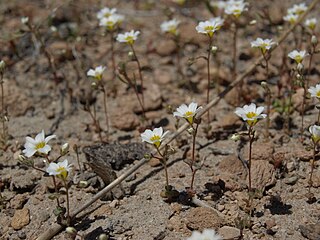
Linanthus inyoensis is a species of flowering plant in the phlox family known by the common name Inyo gilia.
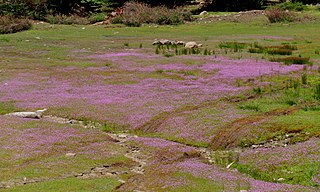
Navarretia leptalea is a species of flowering plant in the phlox family known by the common name Bridges' pincushionplant.

Gilia leptantha is a species of flowering plant in the phlox family known by the common name fineflower gilia.
Gilia transmontana is a species of flowering plant in the phlox family known by the common name transmontane gilia. It is native to the western United States from California to Utah, where it grows in desert and plateau habitat.
Gilia yorkii is a rare species of flowering plant in the phlox family known by the common names Boyden Cave gilia and monarch gilia. It is endemic to Fresno County, California, where it is known from only one location in the southern Sierra Nevada. This plant grows in rock cracks in the limestone cliffs and outcrops in the chaparral and woodlands of the canyon.

Ipomopsis rubra is a flowering plant of the phlox family native to North America from the state of Texas to the province of Ontario, commonly known as standing cypress, scarlet gilia, Texas plume, flame flower, and indian spur. This classification is synonymous with Gilia rubra. This flower is noteworthy for its bright, upturned flowers.
















